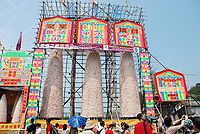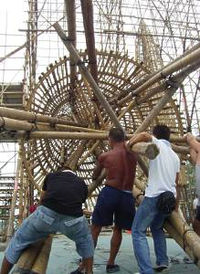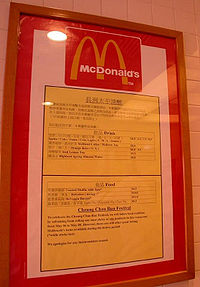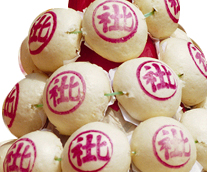
Cheung Chau Bun Festival
Encyclopedia

China
Chinese civilization may refer to:* China for more general discussion of the country.* Chinese culture* Greater China, the transnational community of ethnic Chinese.* History of China* Sinosphere, the area historically affected by Chinese culture...
festival
Festival
A festival or gala is an event, usually and ordinarily staged by a local community, which centers on and celebrates some unique aspect of that community and the Festival....
on the island of Cheung Chau
Cheung Chau
Cheung Chau is a small island 10 km southwest of Hong Kong Island, is nicknamed as the 'dumbbell island' for its shape. It has been inhabited for longer than most other places in the territory of Hong Kong, with a population of about 23,000 up to 2006...
in Hong Kong
Hong Kong
Hong Kong is one of two Special Administrative Regions of the People's Republic of China , the other being Macau. A city-state situated on China's south coast and enclosed by the Pearl River Delta and South China Sea, it is renowned for its expansive skyline and deep natural harbour...
. Being held annually, and with therefore the most public exposure, it is by far the most famous of such Da Jiu festivals, with Jiu (醮) being a Taoist sacrificial ceremony.
Such events are held by mostly rural communities in Hong Kong, either annually or at a set interval of years ranging all the way up to once every 60 years (i.e. the same year in the Chinese astrological calendar). Other places that may share the folk custom include Taiwan
Taiwan
Taiwan , also known, especially in the past, as Formosa , is the largest island of the same-named island group of East Asia in the western Pacific Ocean and located off the southeastern coast of mainland China. The island forms over 99% of the current territory of the Republic of China following...
, Sichuan
Sichuan
' , known formerly in the West by its postal map spellings of Szechwan or Szechuan is a province in Southwest China with its capital in Chengdu...
, Fujian
Fujian
' , formerly romanised as Fukien or Huguing or Foukien, is a province on the southeast coast of mainland China. Fujian is bordered by Zhejiang to the north, Jiangxi to the west, and Guangdong to the south. Taiwan lies to the east, across the Taiwan Strait...
and Guangdong
Guangdong
Guangdong is a province on the South China Sea coast of the People's Republic of China. The province was previously often written with the alternative English name Kwangtung Province...
.
Overview


Chinese calendar
The Chinese calendar is a lunisolar calendar, incorporating elements of a lunar calendar with those of a solar calendar. It is not exclusive to China, but followed by many other Asian cultures as well...
(this is usually in early May). It coincides with the local celebration of Buddha's Birthday
Buddha's Birthday
Buddha's Birthday, the birthday of the Prince Siddhartha Gautama, is a holiday traditionally celebrated in Mahayana Buddhism.- East Asia except Japan :...
.
The Cheung Chau Bun Festival began as a fun and exciting ritual for fishing communities to pray for safety from pirates. Today this religious origin has largely been forgotten, and the festival has mainly become a showcase of traditional Chinese culture
Culture of China
Chinese culture is one of the world's oldest and most complex. The area in which the culture is dominant covers a large geographical region in eastern Asia with customs and traditions varying greatly between towns, cities and provinces...
.
History
One story of the origin of the festival is that in the 18th Century the island of Cheung ChauCheung Chau
Cheung Chau is a small island 10 km southwest of Hong Kong Island, is nicknamed as the 'dumbbell island' for its shape. It has been inhabited for longer than most other places in the territory of Hong Kong, with a population of about 23,000 up to 2006...
was devastated by a plague
Pandemic
A pandemic is an epidemic of infectious disease that is spreading through human populations across a large region; for instance multiple continents, or even worldwide. A widespread endemic disease that is stable in terms of how many people are getting sick from it is not a pandemic...
and infiltrated by pirates until local fishermen brought an image of the god Pak Tai
Pak Tai
Pak Tai is a Taoist god of the North. Many Chinese celebrate his birthday on April 21.-Background:Pak Tai, also named Yuen Tin Sheung Tai , was a prince of the Shang Dynasty. During the fall of the Shang Dynasty, the Demon King ravaged the world...
to the island. Paraded through the village lanes, the deity drove away evil spirits. Villagers also disguised themselves as different deities and walked around the island to drive away the evil spirits.
Vegetarian

Lunar calendar
A lunar calendar is a calendar that is based on cycles of the lunar phase. A common purely lunar calendar is the Islamic calendar or Hijri calendar. A feature of the Islamic calendar is that a year is always 12 months, so the months are not linked with the seasons and drift each solar year by 11 to...
, the islanders organise a weeklong thanksgiving, the Cheung Chau Bun Festival usually in April or May. The festival lasts for seven days. On three of these days the entire island goes vegetarian; most of the island's famous seafood restaurants adhere to this tradition. The local McDonald's also takes meat off the menu and instead sells burgers made of mushroom
Mushroom
A mushroom is the fleshy, spore-bearing fruiting body of a fungus, typically produced above ground on soil or on its food source. The standard for the name "mushroom" is the cultivated white button mushroom, Agaricus bisporus; hence the word "mushroom" is most often applied to those fungi that...
s.
Parade of floats / Parade-in-the-air
In addition to traditional lion danceLion dance
Lion dance is a form of traditional dance in Chinese culture, in which performers mimic a lion's movements in a lion costume. The lion dance is often mistakenly referred to as dragon dance. An easy way to tell the difference is that a lion is operated by two people, while a dragon needs many people...
s and dragon dance
Dragon dance
Dragon dance is a form of traditional dance and performance in Chinese culture. Like the lion dance it is most often seen in festive celebrations. Many Chinese people often use the term "Descendants of the Dragon" as a sign of ethnic identity, as part of a trend started in the 1970s. Another...
s, children dressed as legendary and modern heroes are suspended above the crowd on the tips of swords and paper fans (飘风). They form the parade-in-the-air and are all secured within steel frames, though they appear to glide through the air. Parents consider it a great honour for their offspring to be part of the parade.
This fascinating procession is accompanied by the bedlam of musicians loudly beating gongs and drums to scare away evil spirits. It is led by a spectacular image of Pak Tai
Pak Tai
Pak Tai is a Taoist god of the North. Many Chinese celebrate his birthday on April 21.-Background:Pak Tai, also named Yuen Tin Sheung Tai , was a prince of the Shang Dynasty. During the fall of the Shang Dynasty, the Demon King ravaged the world...
, the God of Water and Spirit of the North, to whom the island's Temple of the Jade Vacuity
Yuk Hui Temple
Yuk Hui Temple also known as Pak Tai Temple , is a taoist temple located on the island of Cheung Chau, Hong Kong. The temple address is Pak She Street, Tung Wan, Cheung Chau.- Introduction :...
is dedicated.
Pak Tai
Since Cheung Chau is traditionally an island of fisherfolk, Pak TaiPak Tai
Pak Tai is a Taoist god of the North. Many Chinese celebrate his birthday on April 21.-Background:Pak Tai, also named Yuen Tin Sheung Tai , was a prince of the Shang Dynasty. During the fall of the Shang Dynasty, the Demon King ravaged the world...
is its most revered divinity, since it is believed he has the power to confer smooth sailing for the fishing boats as well as providing good catches for their crews. Pious believers recognise him as "Pei Fang Chen Wu Hsuan T'ien Shang Ti" (True Soldier and Superior Divinity of the Deep Heaven of the North).
Tin Hau
The second of the significant deities whose images add a supplementary splatter of Oriental holiness to the pageant is the much-revered Tin HauMatsu (goddess)
Mazu , also spelt Matsu, is the indigenous goddess of the sea who is said to protect fishermen and sailors, and is invoked as the patron deity of all Southern Chinese and East Asian persons...
, Goddess of the Seas and protector of all fishermen and boat people. Celebrated for providing warnings of imminent storms and saving countless lives from wreckage, she is in many ways Pak Tai's competitor for the fondness of the fisherfolk.
Kuan Yin and Hung Hsing
Two more gods complete the celestial divinities taking part in the parade: Kuan YinKuan Yin
Guanyin is the bodhisattva associated with compassion as venerated by East Asian Buddhists, usually as a female. The name Guanyin is short for Guanshiyin which means "Observing the Sounds of the World". She is also sometimes referred to as Guanyin Pusa...
, the Goddess of Mercy with her tranquil and ever compassionate smile; and Hung Hsing, the terrifying God of the South with his menacing head-dress, unkind face, bushy black beard, and stave at the ready to chastise all enemies.
Bun snatching

Yuk Hui Temple
Yuk Hui Temple also known as Pak Tai Temple , is a taoist temple located on the island of Cheung Chau, Hong Kong. The temple address is Pak She Street, Tung Wan, Cheung Chau.- Introduction :...
where are the "Bun Mountains" or "Bun Towers"(包山), three giant 60-feet bamboo
Bamboo
Bamboo is a group of perennial evergreens in the true grass family Poaceae, subfamily Bambusoideae, tribe Bambuseae. Giant bamboos are the largest members of the grass family....
tower
Tower
A tower is a tall structure, usually taller than it is wide, often by a significant margin. Towers are distinguished from masts by their lack of guy-wires....
s covered with bun
Chinese bakery
Chinese bakery products consists of pastries, cakes, snacks, and desserts of largely Chinese origin, though some are derived from Western baked goods. Some of the most common Chinese bakery products include mooncakes, sun cakes, egg tarts, and wife cakes....
s. It is those bun-covered towers that give the festival its name. Historically, young men would race up the tower to get hold of the buns; the higher the bun, the better fortune it was supposed to bring to the holder's family; the race was known as "Bun-snatching" (搶包山). However, during a race in 1978 one of the towers collapsed, injuring more than 100 people. In subsequent years, three designated climbers (one climber to each tower) raced up their respective towers and having cleared the top buns proceeded to strip the towers of their buns as they descended.
The three "Bun Mountains" are still placed in the area in front of Pak Tai Temple, and are constructed using the traditional fixation method -- bamboo scaffolding
Scaffolding
Scaffolding is a temporary structure used to support people and material in the construction or repair of buildings and other large structures. It is usually a modular system of metal pipes or tubes, although it can be from other materials...
.
In 2005, a single tower climbing event in the adjacent sports ground was revived as a race -- with extra safety precautions including proper mountain-climbing tools as well as tutorials for participants (which now include women). A teamwork version of the event was added in 2006.The revised version of "Bun-snatching" as well as the traditional three "Bun Mountains" still have their buns removed from the towers at midnight of the Festival.
In February 2007, it was further announced that the buns on the single-tower construct will henceforth be made of plastic. During the festival, Chinese opera
Chinese opera
Chinese opera is a popular form of drama and musical theatre in China with roots going back as far as the third century CE...
s, lion dance
Lion dance
Lion dance is a form of traditional dance in Chinese culture, in which performers mimic a lion's movements in a lion costume. The lion dance is often mistakenly referred to as dragon dance. An easy way to tell the difference is that a lion is operated by two people, while a dragon needs many people...
s, and religious services also take place on the island.
Burning of paper effigies
At a quarter to midnight a paper effigy of the King of the Ghosts is set ablaze, enormous incenseIncense
Incense is composed of aromatic biotic materials, which release fragrant smoke when burned. The term "incense" refers to the substance itself, rather than to the odor that it produces. It is used in religious ceremonies, ritual purification, aromatherapy, meditation, for creating a mood, and for...
sticks are lit and the buns are harvested and distributed to the villagers, who, pleased to be sharing in this propitious good fortune, rejoice late into the night.
Return of bun-snatching
As aforementioned, the bun-snatching ritual was abandoned by the government due to the 1978 collapse. Still, a large portion of Cheung Chau villagers regard this as part and parcel of their daily life, and the precious culture of Hong KongCulture of Hong Kong
The culture of Hong Kong can best be described as a foundation that began with China, and became more influenced by British colonialism. Despite the 1997 transfer of sovereignty to the People's Republic of China, Hong Kong continues to hold an identity of its own.-People in the culture:Most Hong...
to boot. In addition to the villagers' immense urge to resume the ritual, a local cartoon movie My life as McDull
My Life as McDull
My Life as McDull is a Chinese animated feature film from Hong Kong released in 2001. The film surrounds the life of McDull, a hugely popular cartoon pig character created by Alice Mak and Brian Tse which has appeared on comics ever since the 1990s...
recalled the forlorn ceremony, giving a tinge of nostalgia to its audience. As such, the long-awaited ritual was reintroduced on 15 May 2005. Safety measures were intensified: only 12 well-trained athletes selected from preliminary competitions were permitted to climb on one single "Bun Mountain"; instead of bamboo, the framework of the "Bun Mountains" was made up of steel
Steel
Steel is an alloy that consists mostly of iron and has a carbon content between 0.2% and 2.1% by weight, depending on the grade. Carbon is the most common alloying material for iron, but various other alloying elements are used, such as manganese, chromium, vanadium, and tungsten...
.
More about My life as McDull and bun-snatching
My life as McDullMy Life as McDull
My Life as McDull is a Chinese animated feature film from Hong Kong released in 2001. The film surrounds the life of McDull, a hugely popular cartoon pig character created by Alice Mak and Brian Tse which has appeared on comics ever since the 1990s...
was a sizable hit in Christmas 2001. This Hong Kong animated feature was primarily targeted at children. Aside from the cute character designs, however, My Life as McDull had also shown many renowned qualities of Hong Kong
Hong Kong
Hong Kong is one of two Special Administrative Regions of the People's Republic of China , the other being Macau. A city-state situated on China's south coast and enclosed by the Pearl River Delta and South China Sea, it is renowned for its expansive skyline and deep natural harbour...
people — hard-working, carefree, and never giving up. The "Hong Kong dream" depicted in the film has charmed much of its audience. The animation is aided by computer-generated backgrounds, but it retains a delightful hand-drawn look that is pleasing to the movie-goers. In a part of the film, McDull
McDull
McDull is a cartoon pig character that was created in Hong Kong by Alice Mak and Brian Tse. Although McDull made his first appearances as a supporting character in the McMug comics, McDull has since become a central character in his own right, attracting a huge following in Hong Kong.-McDull's...
decides to train to be an Olympic-level athlete like Hong Kong Olympian Lee Lai-shan. However, the trade he learns is Cheung Chau bun-snatching. Realising that bun-snatching is not a formal sporting event in the Olympic games
Olympic Games
The Olympic Games is a major international event featuring summer and winter sports, in which thousands of athletes participate in a variety of competitions. The Olympic Games have come to be regarded as the world’s foremost sports competition where more than 200 nations participate...
, McDull’s mother writes a letter to the chairman of International Olympic Committee
International Olympic Committee
The International Olympic Committee is an international corporation based in Lausanne, Switzerland, created by Pierre de Coubertin on 23 June 1894 with Demetrios Vikelas as its first president...
(IOC) to ask him/her to sanctify the so-called sports event with her limited proficiency of English.
Some people think that the Hong Kong Tourism Board
Hong Kong Tourism Board
The Hong Kong Tourism Board is a Government-subvented body founded in 2001. The Board replaced the Hong Kong Tourist Association established in 1957...
began to promote the forlorn ritual thanks to the unanticipated box-office success. It spawned a laughing stock, though, when the Secretary for Home Affair, Patrick Ho Chi-ping, said he might contact IOC later on in order to formalise the "sports". He even told to the public that the bun-snatching ceremony can be varied into many other events, like cake-snatching ceremony, doll-snatching ceremony, etc..

